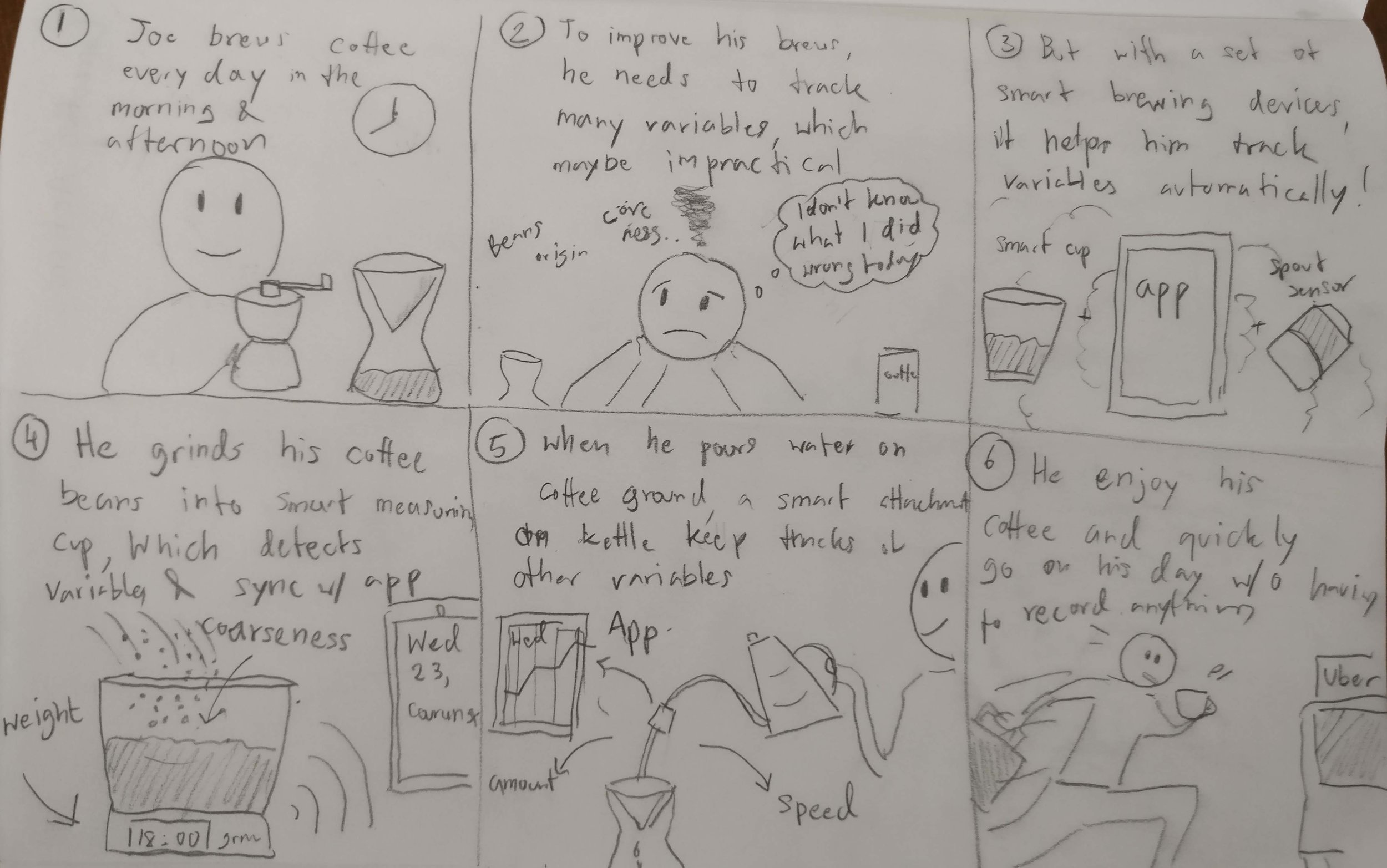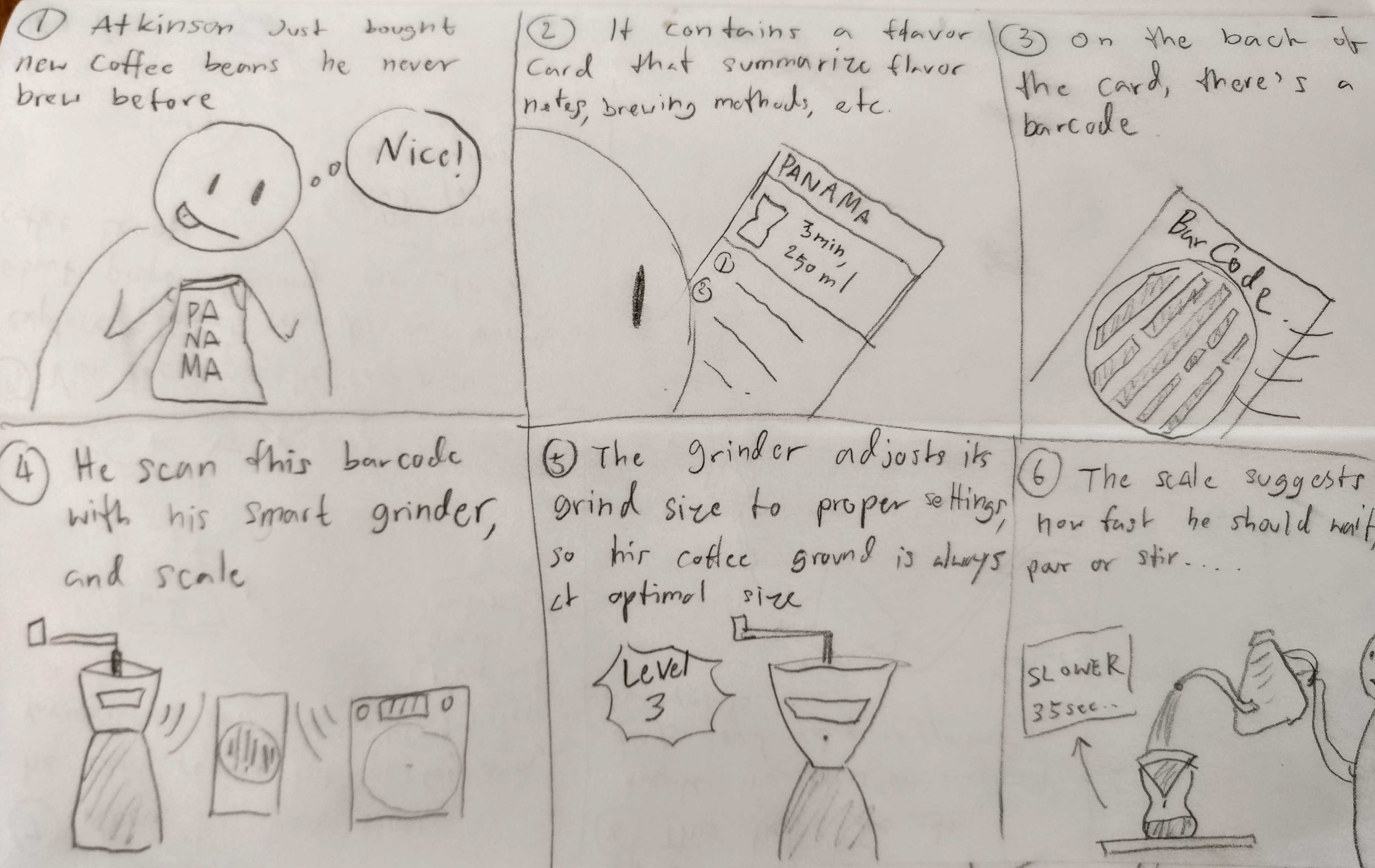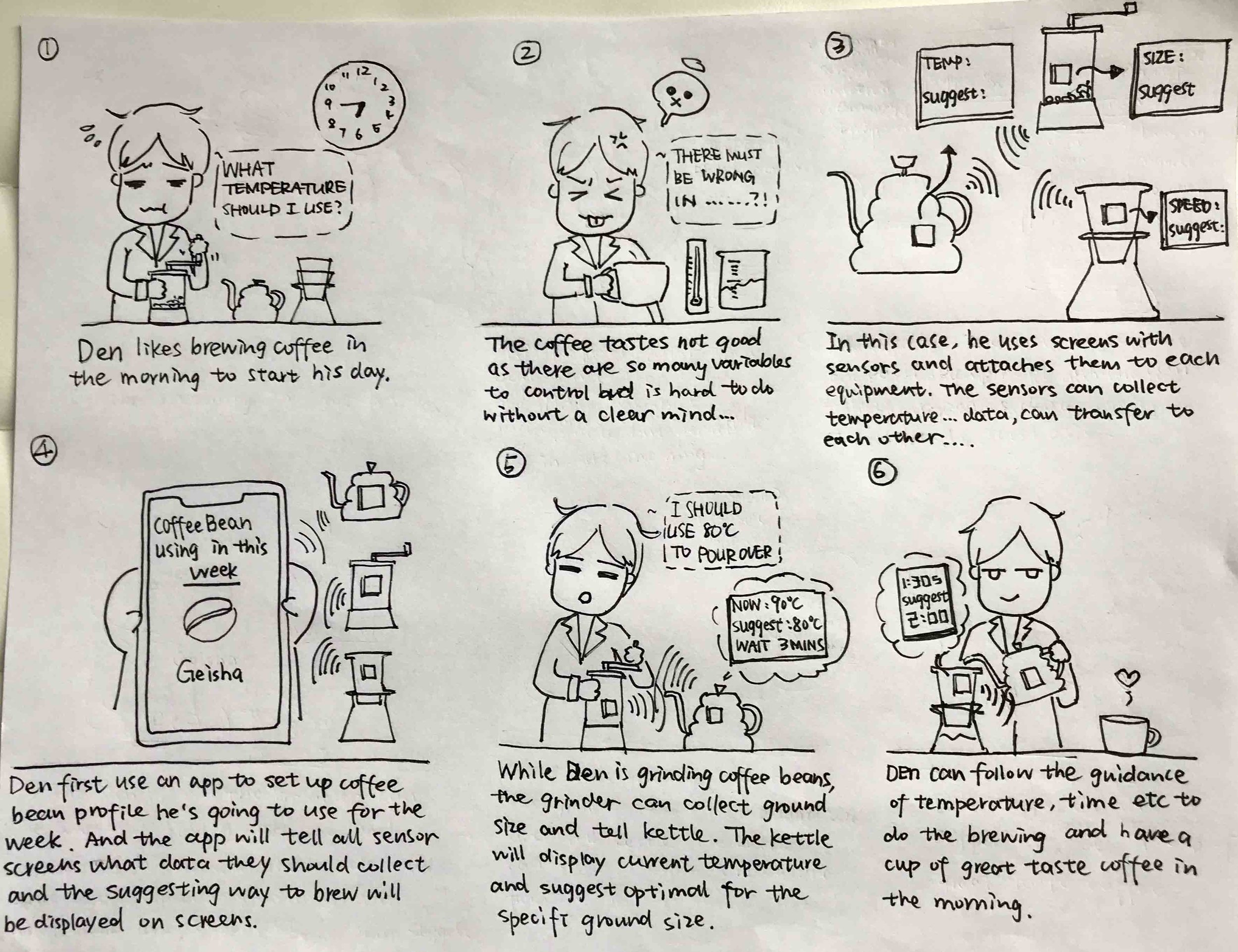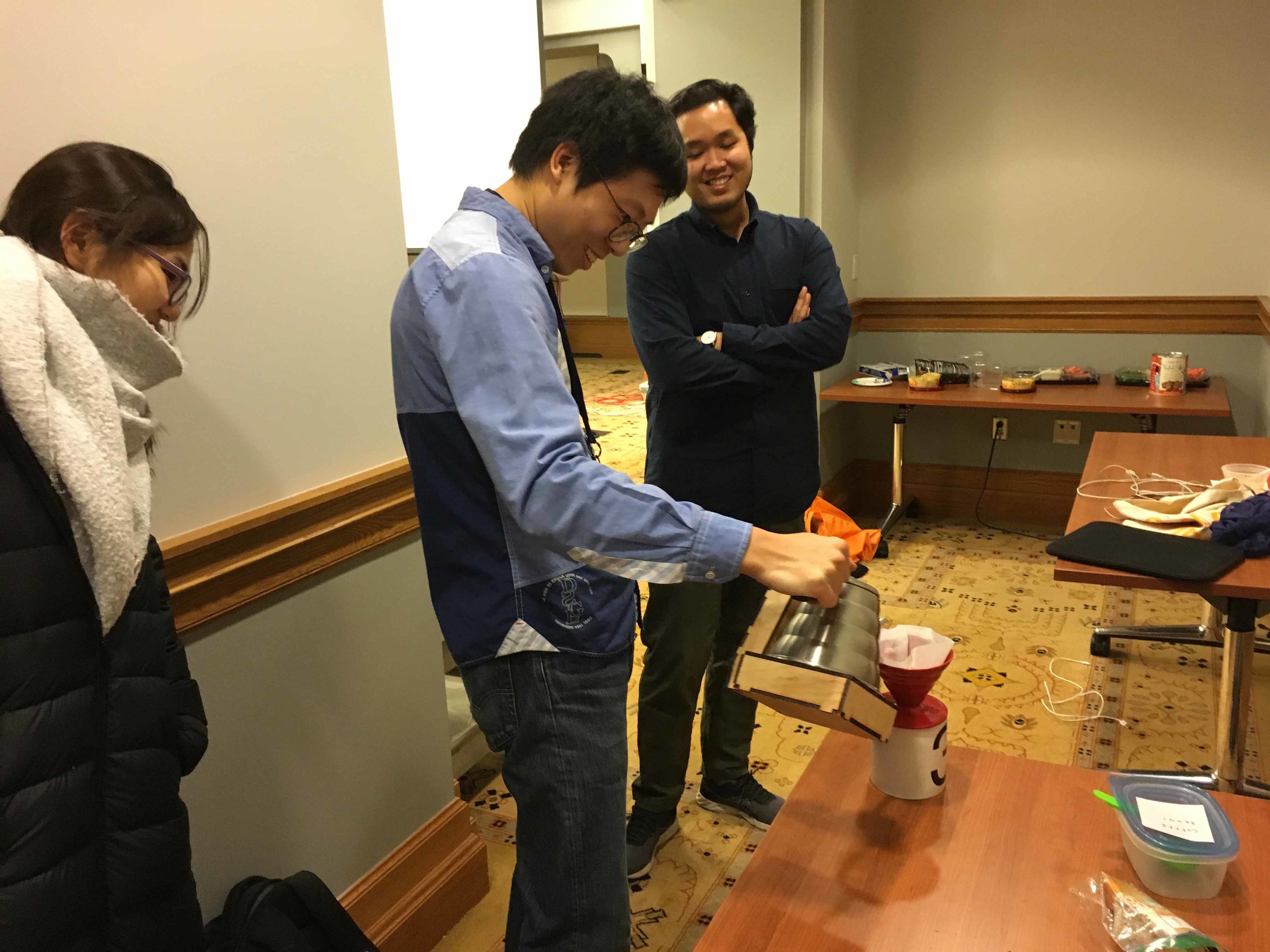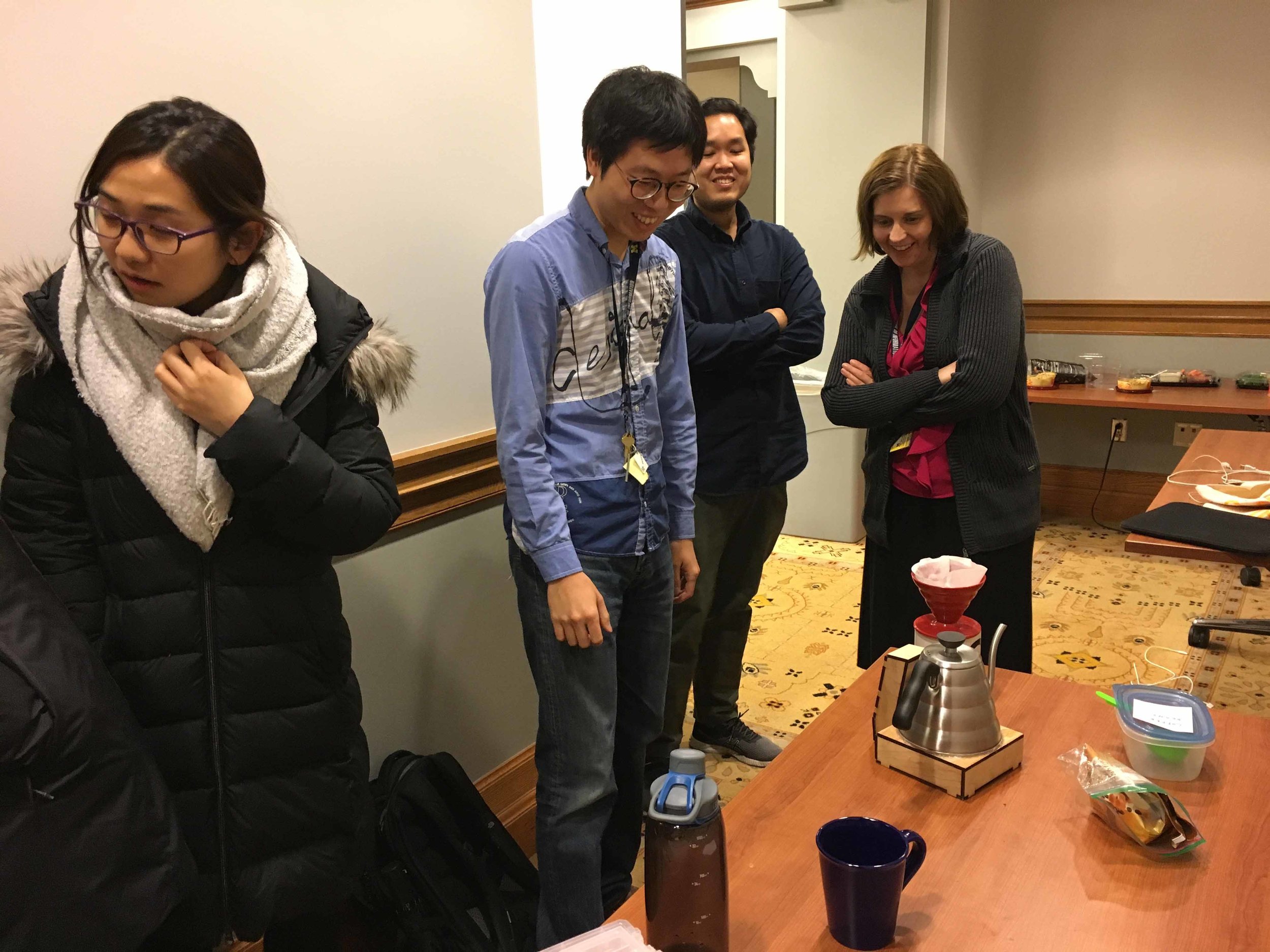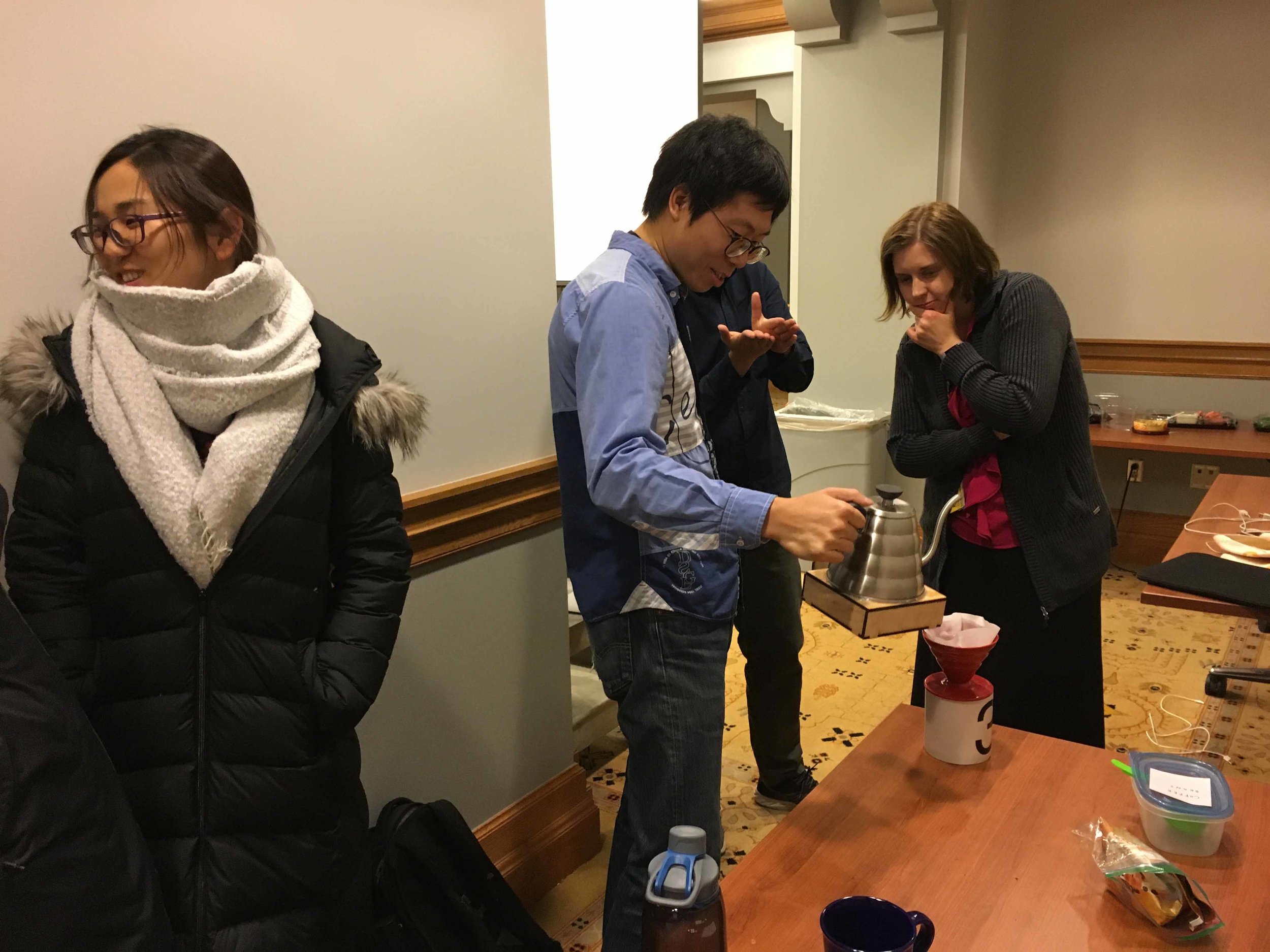Stefan Deuchler
Human Computer Interaction
Coffever
Project&Role
Semester-long Group Project
UX Researcher, UX Designer
There are many different ways to prepare coffee. Between the classic drip coffee and the Italian espresso, there are many ways to arrive at a cup of freshly brewed coffee. For every brewing method, there exists a variety of tools that require more or less human intervention. For our project, we focused on people that are passionate about brewing their own coffee. Those are people that appreciate the complexities of flavor in the finished product and don’t just drink coffee to get a caffeine fix. We further narrowed down our scope to those coffee aficionados who are interested in brewing their own coffee. When doing preliminary research, we learned that the pour-over method is often used by coffee enthusiasts these days as it offers the brewer a variety of ways to tweak the brewing process. It doesn’t require special machinery apart from a simple dripper and a paper filter. Scales, thermometer and grinder can all be analog and are often already found in a typical kitchen.
While it’s easy to get started, the process of brewing a good cup of coffee using the pour-over method can be overwhelming for beginners as there are so many variables that have to be controlled. What’s maybe the most compelling reason for coffee lovers to brew their own coffee using the pour-over method is that there are different styles of performing the pour-over, which are propagated throughout the coffee enthusiasts’ community. Even a seasoned coffee brewer can thus adjust their style and tweak the various variables that are involved in the process to come up with coffee that tastes different every time.
Understanding the process of brewing coffee using the pour-over method
Motivation
In this preliminary research phase, we aimed to understand coffee enthusiasts’ experience of manually brewing coffee at home. We learned about various methods of brewing coffee through online research. Most importantly, we conducted an interview with a coffee lover to understand the process of manually brewing coffee at home and what their frustrations were. We learned the following:
- Brewing coffee manually is a complicated process that involves many steps and variables
- Coffee lovers enjoy being immersed in the process and they care about getting the details right
- They are often unsure about how fast and how to pour over water in the dripping process
- Getting the water temperature and ground size of coffee beans right is difficult
- The potential for frustration is high, especially for novice coffee brewers
Diary Study
We recruited three users to conduct a diary study by using a University of Michigan School of Information email list and Facebook. We asked the participants to note their thoughts, feelings and emotions whenever they were brewing coffee at home. The diary study was motivated by the following research questions:
- How is the brewing process integrated into the participants’ daily life?
- What are the participants feeling during the brewing process, what kind of emotions come up?
- What setting is the process physically embedded in?
We sent each participant detailed prompts and encouraged them to take pictures of an object or any kind of coffee-related activity that left them feeling particularly happy or frustrated for a period of at least 4 days.
We also conducted a post-study interview with each of the diary-study particpants.
Diary study participants sent us detailed recordings of their coffee brewing activities during 5 days
Brainstorming prompts and questions for dairy study and in-depth interviews
In-depth Interviews
We conducted two in-person interviews with coffee enthusiasts who brew their own coffee at home using the pour-over method. The in-depth interviews were motivated by the following research questions:
- How do different people apply the pour-over method? Is there a lot of variety between users?
- What are some of the frustrations that people encounter when using the pour-over method?
- Can we uncover design opportunities by listening to users needs and frustrations?
One diary study participant was frustrated with how messy their hand-grinder got every time they ground coffee beans.
We built an affinity wall with the diary study and interview results
Analysis of study results
After conducting the in-depth interviews and the post-study recaps, we individually reflected on our results. We then held an interpretation session to go over the interviews as a group. During this step, we wrote insights and quotes on yellow sticky-notes and stuck them to our affinity wall. We read out loud our notes and regrouped them around common themes. We spent around ten minutes on regrouping and then labelled each group with blue notes. Finally, we consolidated those groups again and labelled them with green notes. Based on our affinity wall, we had the following findings and insights.
- Coffee lovers enjoy brewing coffee themselves at home rather than buying the ready-to-go variety, which is usually diluted with milk and loaded with sugar, even though the process is often challenging and results are hard to control. Coffee lovers do not want to automate the brewing process.
- Controlling all the variables that determine the quality of the coffee is challenging and scares novice users off of manual brewing methods, such as the pour-over method
- Coffee lovers enjoy learning, whether it is a new pour-over pattern, getting to know various coffee roasting methods, or experimenting with various tools. They are always exploring, experimenting, failing and starting and tweaking again and never stop.
- There is no one-size-fits-all formula or specific routine for brewing coffee. Each coffee enthusiast has their own methods and they like to share their insights with the coffee lover community.
Ideation & Selection
During the ideation process, we first brainstormed and sketched individually based on our research findings. Then we synthesized our findings and analyzed them together to share our insights. Based on our analysis, we agreed on the following criteria to evaluate our concepts:
- Facilitate, don't automate: People appreciate brewing their own coffee by themselves. It’s fun and enjoyable to have challenges. So the design shouldn’t be too automatic.
- Nonintrusive: Keep the design simple and don’t add more burden and distractions for the user.
- Enjoyable: the design should be fun and enjoyable to use.
- Save time: Users often brew coffee during busy times of their day so the design should help them save time.
- Include information processing and/or networking elements: as this is a pervasive interaction design project, the artifact must use these elements as a part of the solution in some way and not solely relying on industrial design.
Design Concepts
Analysis and Brainstorming Session
Refined Scope
Original scope: To help coffee aficionados to brew coffee at home.
Refined scope: To facilitate coffee aficionados enjoying coffee brewing activities at home.
Audience: coffee aficionados
- Use pour-over brewing methods
- Appreciate coffee and value challenges and and element of surprise in the brewing process
- Care about one's brewing skills
User Enactment Studies
To better understand how our design ideas would resonate with our target audience, we planned to conduct User Enactment studies guided by Davidoff et al.’s Speed Dating Matrix. First, we brainstormed possible dimensions for the matrix based on our previous fieldwork. We came up with the following principal dimensions:
- Technology Intervention
- Modality of feedback
- Level of Busyness
User Enactment Study Props and Arrangement
Study Design
We recruited a total of five participants for our User Enactment studies.
We created seven scenarios that correspond to the various intersections on our speed dating matrix.
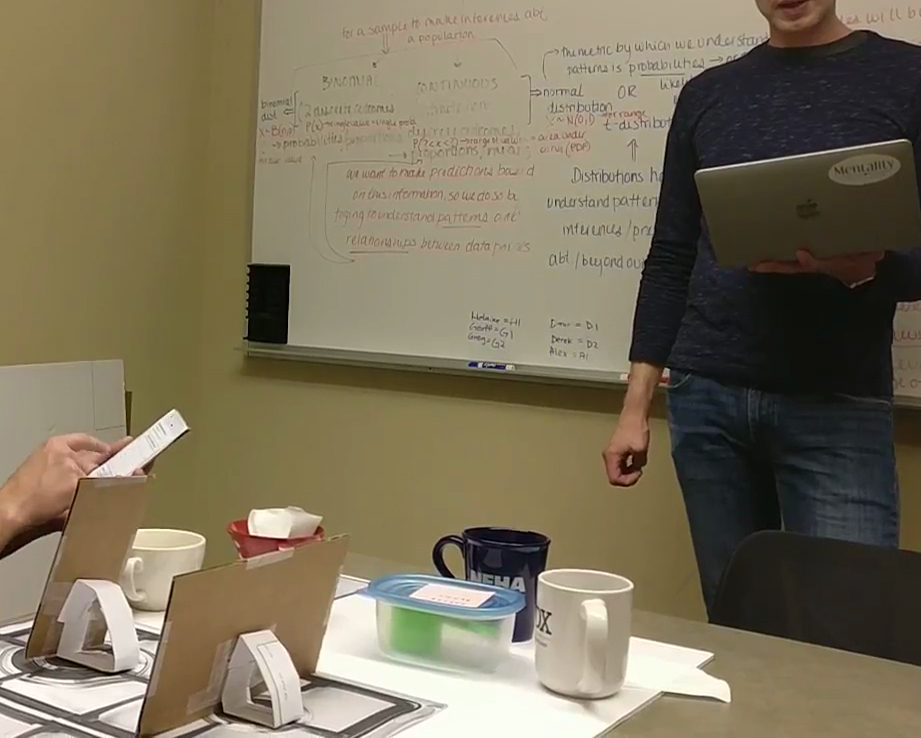
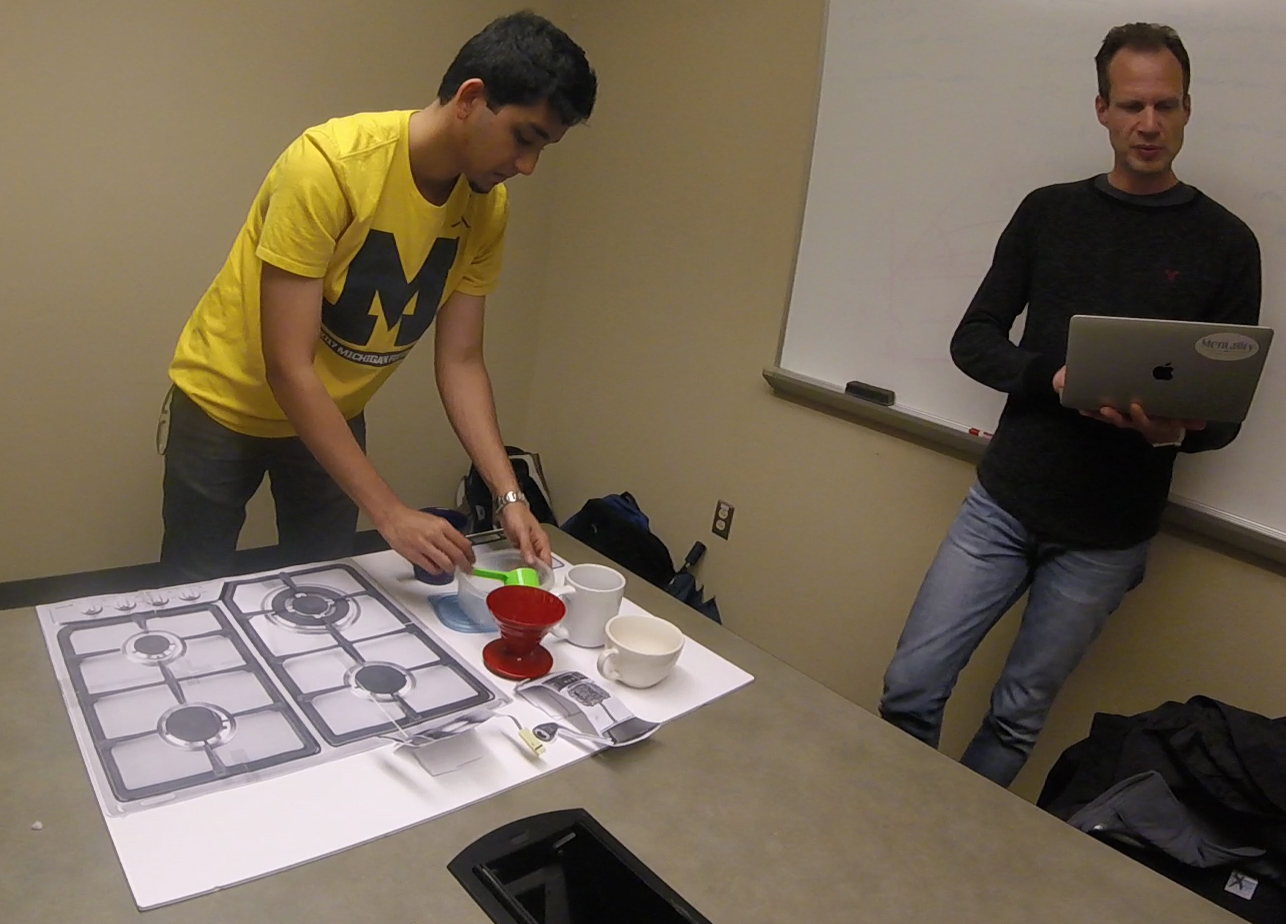
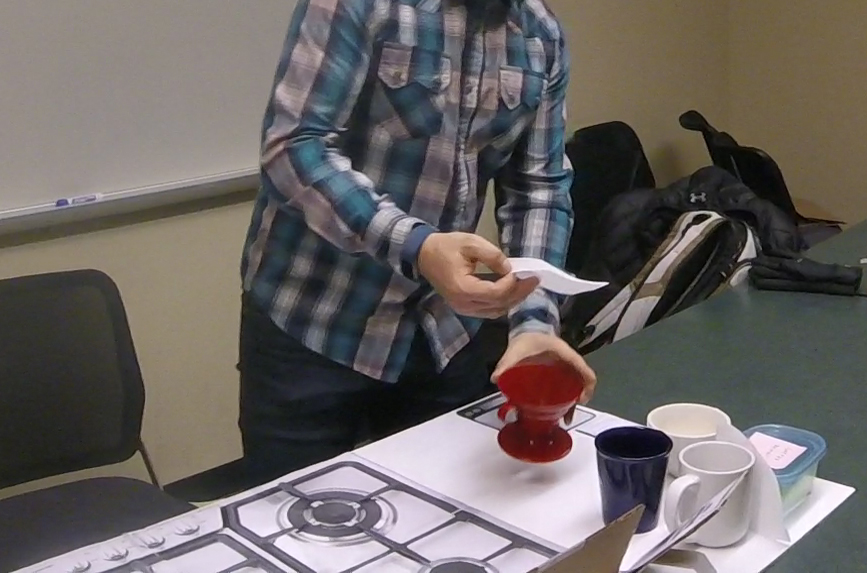
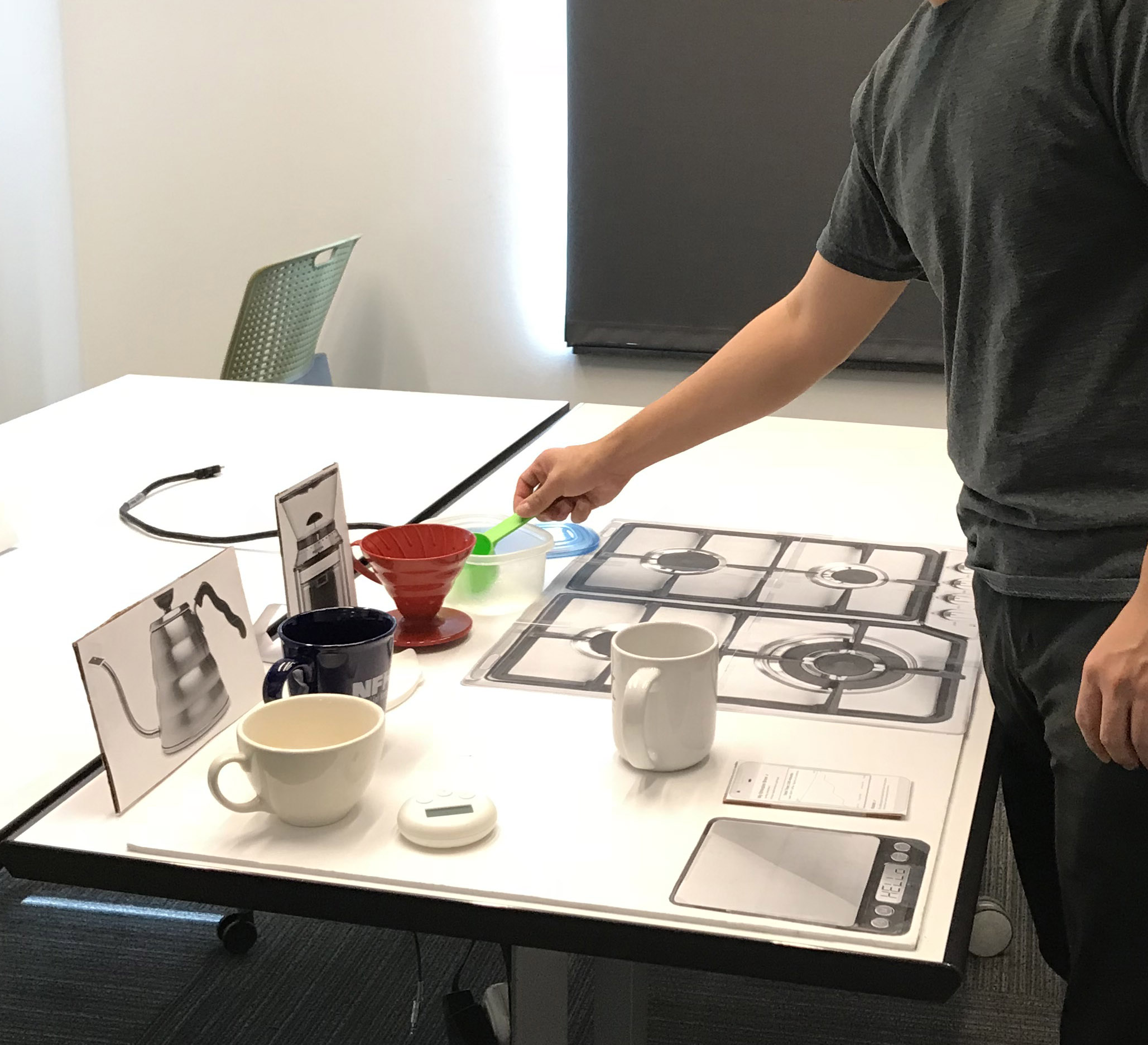
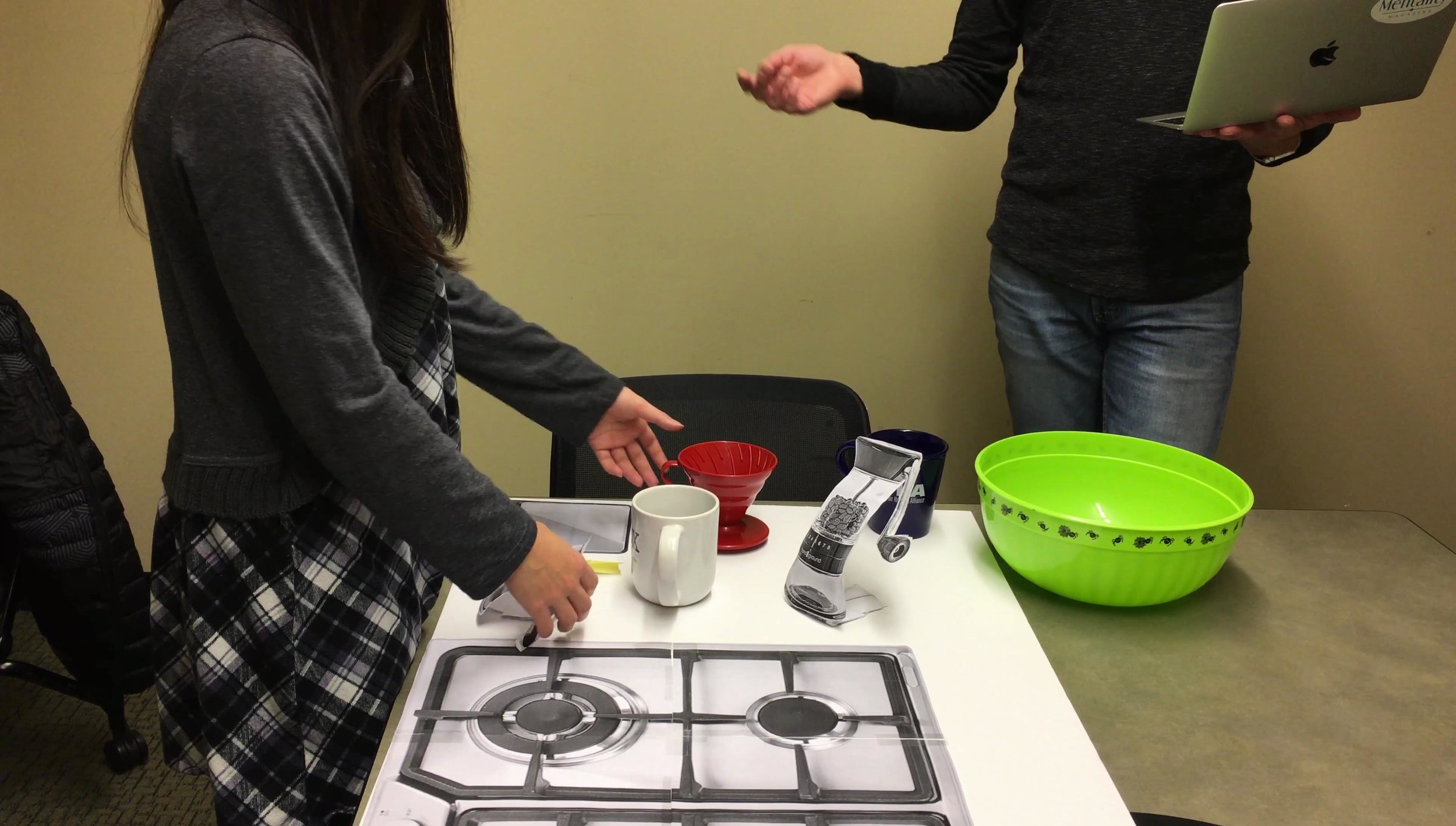
Analysis of User Enactment Study Results
Based on video recordings and the notes we took during the sessions, we reflected individually and gathered key findings in terms of the Speed Dating Matrix. We then met as a group and aggregated our individual findings by reading through the notes together, moving notes around, labeling and highlighting the final key findings and insights.
“Situated between sketching and prototyping, Speed Dating structures comparison of concepts, helping identify and understand contextual risk factors and develop approaches to address them.”
Setup and Props
- We used two kettle variants: An electric kettle that’s connected to a water line that automatically heats up water and keeps it at the optimal temperature. The kettle has built-in valve at the tip of the spout that controls water flow (speed).
The second variant consists of a gooseneck kettle spout-attachment with sensors that measure water flow (speed), total amount of water, and water temperature. Can be attached to any standard gooseneck kettle. - The Smart Grinder measures the weight of the beans as well as the coarseness of the coffee grounds. It automatically grinds beans until the grounds have reached the desired coarseness level.
- The smartphone app is designed to show the user visualizations of the settings and variables that were last used, such as weight of coffee beans, temperature of water during each pour, amount of water per pour, and coarseness of coffee grounds.
All three devices are connected to each other via bluetooth and exchange data with each other. The smart grinder lets the smart kettle know how many grams of coffee grounds are used, which in turn will allow the smart kettle to ensure that correct amount of water is dispersed.
Key Findings and Insights
- Instant feedback is more helpful during the pouring over process step, while summary data helps users make adjustments to process variables during future brewing sessions.
- People welcome a high level of intervention from the system when trying something new or during a busy morning, but they prefer less intrusion during parts of the day that are less busy.
- Our design should not control everything for the user, but provide suggestions instead and leave it up to the user to decide which parts of the process they would like to manually adjust.
- As visual feedback was preferred by our study participants we should focus on providing visual information and cues, but we should consider adding other modalities as supplementary feedback when appropriate.
Explaining our ideas to each other
Ideation
Based on our key findings and insights, we then started our next round of ideation. After a bodystorming session, we defined the criteria we we're going to analyze all of our ideas against and selected those ideas that scored highest on our criteria.
Proposed System
Based on the ideas we selected above, we were proposing an interconnected ecology of coffee brewing equipment and smartphone app that work together via wireless radio frequency. Our proposed system included a Smart Gooseneck Kettle, a Smart Coffee Grinder, as well as a smartphone app. Our belief was that the technologies required to build this system already exists and that such a system could be manufactured in a timespan of 6-12 months.
Demo Proposal (Prototype)
To better communicate our proposed system, we decided to build an interactive prototype that we could showcase during the demonstration session at the end of the semester. Our prototype would consist of the following parts:
- Smart kettle
- Automatic grinder
- Smartphone Application
Prototype
Smart Grinder
Smart Grinder learns about the type of coffee beans the user is using by scanning a QR code from a coffee pouch. Additionally, Smart Grinder measures the weight of the coffee grounds and grinds only the correct amount of beans. Smart Grinder determines the weight of the grounds by the type of beans used, as well as settings the user can control via Smartphone App.
Smartphone App
The companion Smartphone App allows the user to control the brewing result by setting the desired amount of coffee. The Smartphone App then determines the desired weight of coffee grounds based on the beans used. The Smartphone App also tells the user which coarseness setting would be ideal for the beans used. Additionally, the Smartphone App visualizes the brewing process by displaying an overview of the temperature and the pouring speed which gives the user an opportunity to review the brewing process. The user can also enter taste notes about the final product.
Smart Kettle
Smart Kettle is an electric kettle that detects the presence of a user and reminds them to start the brewing process. Once the user has filled Smart Kettle with water, Smart Kettle heats up the water to a predefined temperature. Smart Kettle will guide the user through the pour-over process by showing a graph on an LCD display that tells the user what the ideal pouring speed is in comparison to the user’s current pouring speed. Smart Kettle measures the speed of water flow as well as the amount of water poured to determine how long each pour should last. Smart Kettle determines the amount of water per pour based on settings the user can control via the Smartphone App.
Building the Prototype
For our demonstration, we decided to build a prototype that focuses on assisting the user with the pour-over process. Instead of measuring the water flow per second and amount of water poured, we decided to use a tilt-sensor to measure the angle with which the user is holding the kettle. The steeper the angle, the more water is estimated to flow per second. The system then visualizes the actual pouring speed (as determined by the angle) as well as the ideal pouring speed on an LCD display. Additionally, our prototype detects the presence of the user, greets the user, and reminds them to fill the kettle with water.
We decided against prototyping the experience of using Smart Grinder and companion app for various reasons. We felt that we would prefer to focus on the Smart Kettle since we estimated hardware and software design and execution to take up a a considerable amount of time. Regarding the Smartphone App, we did not think that a prototype would have helped to convey the core experience of our system. We decided that a screen or two of UI mockups should be enough to demonstrate our point.
Components
For our prototype, we used the following components:
We iterated on our Smart Kettle concept and discussed various ways of adding a plywood housing to a traditional gooseneck kettle. We eventually came up with a design which we then cut into plywood using a laser cutter.
- Particle photon
- LCD Display
- Speaker
- Ultrasonic Proximity Sensor
- 6-Axis Gyroscope and Accelerometer
- Push button
- Plywood for laser-cutting the housing
- Gooseneck kettle
Laser-cutting the housing components
Glueing the plywood components together
For the electronics, we put together the electronics components and wrote the C++ code for the Particle Photon. Initially, we thought of using a flow sensor to directly measure the amount of water being poured, but that approach was too complicated as we had to think about how to integrate the sensor with the kettle.
As an alternative, we first used a gyroscope to measure the angle the kettle is held with, and derived, approximately, the resulting amount of water that would be poured. However, it turned out that the gyroscope was too hard to work with, so we decided to use an accelerometer instead.
Cutting the plywood required quite a bit of trial and error, especially for cutting the dovetails. We learned that the laser cutter is not as precise as we first assumed, so the pieces often didn’t correctly fit together.
We learned that it is difficult to show our prototype to a large audience because of the small LCD screen. We rehearsed the demo multiple times to ensure that we were familiar with all the steps. Ideally, we would have added more interactions and increased the precision to our demo, but with our time constraints, we ensured that we focused on presenting a working demo rather than failing at a more complicated one. We applied the same philosophy to the building process: We initially had a different casing in mind, but then realized that it might require a few iterations to get it right, so we decided on a simpler case design with the focus on getting it built in time.
Live Demo
This video shows our prototype in action



